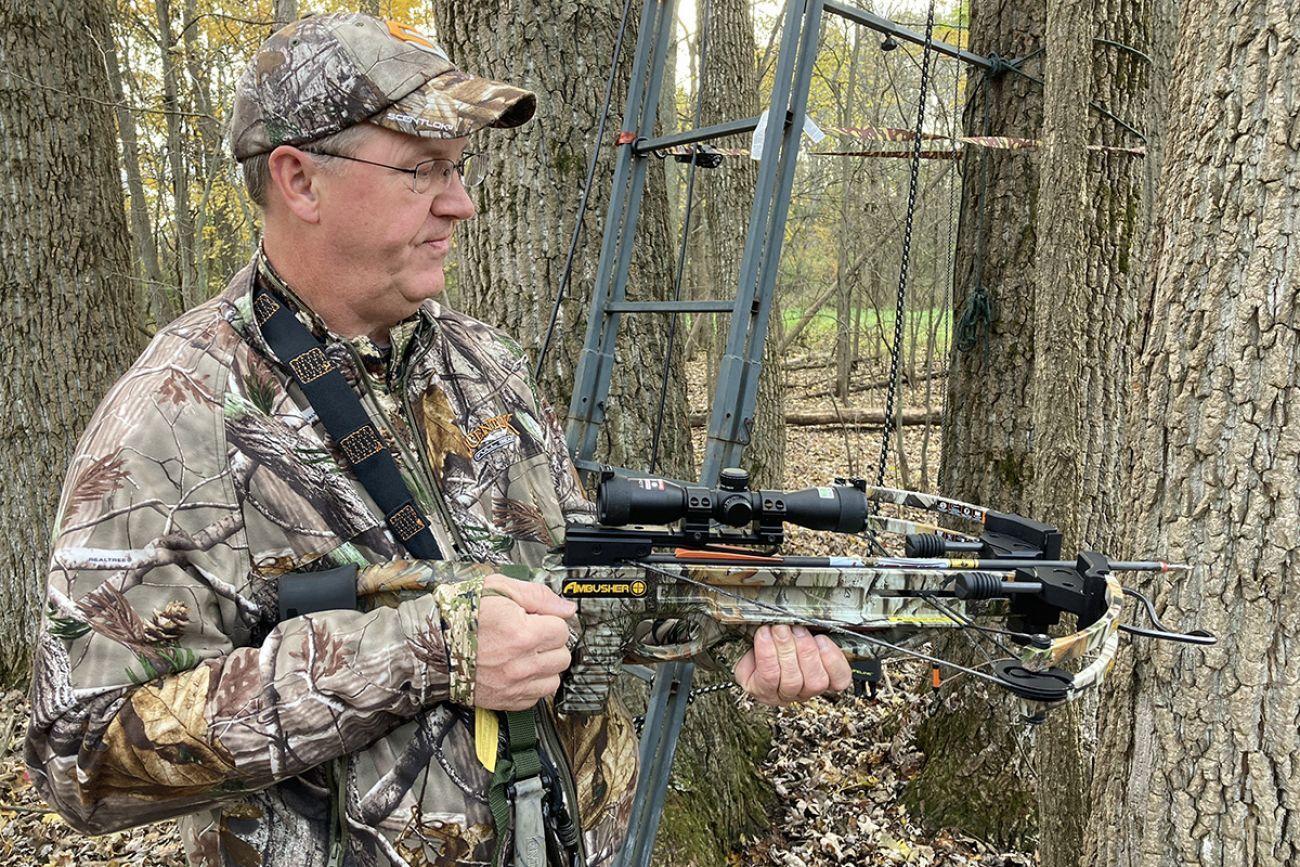Few good options for shrinking Michigan’s problem deer herds

- Growing deer herds are causing trouble in Michigan
- Consequences include crop and forest damage, car crashes and disease
- Michigan’s deer population control options are limited
Few creatures look more harmless while doing more destruction than the urban deer.
They spread disease and dash in front of cars, sometimes resulting in accidents. They devour farm fields, gardens and forests, killing off songbirds while allowing invasive species to spread.
But it’s not all their fault: Humans have created the ideal conditions for deer to survive and reproduce to problematic levels, said Chad Stewart, deer, elk and moose management specialist for the Michigan Department of Natural Resources.
Related:
- As hunting wanes, fear of a southern Michigan deer invasion grows
- No joke: Ann Arbor is removing deer ovaries. Lawmakers aren’t laughing.
- Michigan deer hunters decline as pandemic boost in hunting wanes
“We tend to see much higher survival rates in deer that live in urban settings,” Stewart said Thursday, as he informed the state Natural Resources Commission of Michigan’s options for reducing urban deer populations.
Stewart estimates there may be up to two million deer in Michigan today. For context, resource managers 80 years ago were concerned about overpopulation when the herd was half as large.
Like the bulk of Michigan’s human inhabitants, most of today’s deer are clustered in the southern Lower Peninsula. That’s a recipe for conflict.
But despite growing complaints about deer from Oakland County to Ann Arbor, regulators say they have few dependable options for curbing deer numbers. Bridge spoke to Stewart about why deer have become so abundant, and how species managers are responding.
Here’s what you need to know:
What’s causing the problem?
Several factors contribute to southern Michigan’s deer boom.
Across much of the Lower Peninsula, humans long ago wiped large predators off the landscape. That left hunters as the remaining check on deer population growth. But hunting has been losing popularity for decades, and today’s hunters kill fewer deer-per-person. They also tend to target adult male deer known as bucks, which does little to control population since bucks don’t give birth.
Michigan’s relentless suburban sprawl also plays a key role. And it turns out, the suburbs aren’t a bad place for a deer. There are few predators. Plenty of garden beds to munch on. Few publicly-accessible open spaces where hunters can shoot deer without angering and possibly endangering the neighbors.
Climate change may also be a factor. Bitter winters are a check on deer abundance, and Michigan is simply having fewer of them.
Combine all that with the fact that a healthy deer can give birth to twins or even triplets each spring, Stewart said, and you’ve got a recipe for population growth.
What are the risks?
The risks are many.
More deer in a heavily-populated area means more risk of slamming into one with your car. More than 52,000 deer-vehicle crashes occurred in 2021 in Michigan, ten of them fatal. Oakland County had the highest toll, followed by Kent County.
“They just happen to be two counties where one, we have a lot of deer and two, we have a lot of people,” Stewart said.
And diseases like Lyme disease, bovine tuberculosis (a bacterial lung disease affecting cattle, deer and in rare cases humans) and chronic wasting disease (a fatal neurodegenerative illness affecting hoofed animals) spread more easily in dense herds.
While Lyme disease is a growing threat in Michigan, human cases of bovine tuberculosis are extremely rare and there has never been a documented human case of chronic wasting disease.
Beyond risk of crashes and disease, deer can destroy forest ecosystems, suburban hosta gardens and farmers’ crops. One study found that in Presque Isle County alone, deer consumed a tenth of farmers’ soybeans. In overbrowsed forests, saplings disappear and mature trees have a manicured look from deer nibbling branches as high as their necks can reach. That eliminates habitat for ground-nesting songbirds and other animals.
What can we do about it?
There are four key strategies for driving down deer populations: Hunt harder, reintroduce predators, sterilize female deer or trap and kill the animals. All come with tradeoffs.
“There’s not one option that is going to be universally supported, inexpensive, and efficient,” Stewart said. “You might be able to get one or two of those features, but you're not going to get the third.”
Hunt harder
Aggressive hunting, in theory, would be a cheap and efficient way to kill more deer.
But interest in recreational hunting has been declining for years, and the hunters that remain have not shown an interest in killing more deer. What’s more, Stewart said, the fragmented landscapes in suburban areas with the most complaints about deer are difficult to hunt.
“You don't want a deer going across like 10 property lines and then expiring,” Stewart said, “And then having that person have to track that animal through people's backyards when they're trying to enjoy a quiet evening on the deck.”
Some communities have successfully launched volunteer deer-hunting programs or hired sharpshooters to do the job, but the programs only work if the effort is sustained for many years.
Predator reintroduction
So what about reintroducing big predators, like wolves and cougars that once roamed all of Michigan but are now confined to the U.P. wilderness?
As you might think, it’s a no-go in the suburban areas where deer overpopulation is most pronounced, Stewart said.
“If people are concerned about too many deer, they're going to be just as concerned about having mountain lions in their backyard,” he said.
It wouldn’t be good for the cougars or wolves, either. Both animals are territorial, and require vast ranges for hunting, breeding and raising their young.
While southern Michigan may contain plenty of deer for them to eat, Stewart said, “an animal needs more than just food to survive.”
Sterilization
Ann Arbor briefly maintained a deer sterilization program as part of a population-control effort that also included sharpshooters. The program has since been put on hold.
The chief problem with sterilization programs, Stewart said, is they’re “really expensive.”
Surgical sterilization can cost more than $1,000 per deer. And to curb population growth, Stewart said, more than 80 percent of female deer must be sterilized.
That’s difficult to achieve, especially when deer are constantly migrating in and out of areas.
Contraceptive drugs can be hand-injected or darted into deer. But those drugs, which are federally-classified as pesticides, aren’t approved for use in Michigan. And they require follow-up doses to become effective, posing a major logistical challenge.
“I don't see it ever being an option,” Stewart said.
Trap and kill
Trapping deer in cages and then killing them is expensive and labor-intensive.
The tactic could be useful in communities that prohibit hunting with rifles or bow-and-arrows, Stewart said. But trapping deer puts “a lot of stress on the animal,” making it a less-humane option than simply killing deer outright.
Michigan doesn’t allow relocation of trapped deer because relocated animals have low survival rates and moving deer could spread disease between herds, Stewart said.
DNR officials regularly advise communities on how to cope with problem deer. But given the limitations of population-control options, Stewart said, Michigan’s best hope is likely slowing population growth, rather than reversing it.
“You're only going to get more and more parcelized landscapes and suburban sprawl that limits (hunting) access,” he said. “And deer are going to continue to do what deer do, which is reproduce really, really well.”
Michigan Environment Watch
Michigan Environment Watch examines how public policy, industry, and other factors interact with the state’s trove of natural resources.
- See full coverage
- Subscribe
- Share tips and questions with Bridge environment reporter Kelly House
Michigan Environment Watch is made possible by generous financial support from:
Our generous Environment Watch underwriters encourage Bridge Michigan readers to also support civic journalism by becoming Bridge members. Please consider joining today.
See what new members are saying about why they donated to Bridge Michigan:
- “In order for this information to be accurate and unbiased it must be underwritten by its readers, not by special interests.” - Larry S.
- “Not many other media sources report on the topics Bridge does.” - Susan B.
- “Your journalism is outstanding and rare these days.” - Mark S.
If you want to ensure the future of nonpartisan, nonprofit Michigan journalism, please become a member today. You, too, will be asked why you donated and maybe we'll feature your quote next time!






